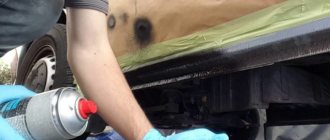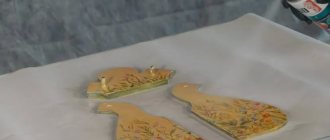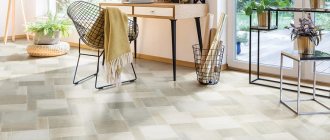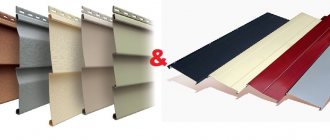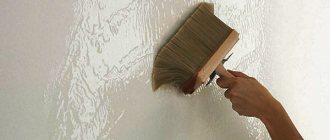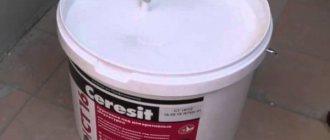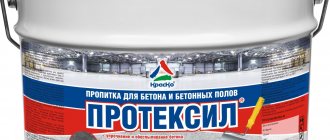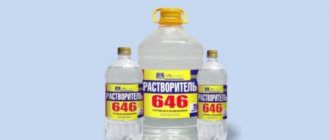Any person who cares about the condition of their personal transport regularly faces problems with repairing and restoring paintwork. We prefer to repair small scratches or chips with our own hands, fortunately, modern industry provides enough opportunities for this. If you wish, you can buy a lot of different primers for paint and surface protection, restorers of mirror shine and color of the coating, all sorts of stain removers and polishing compounds, both in regular packaging and in an aerosol can.
Pros and cons of soils in cans
Benefits of using an aerosol primer:
- completely ready for use;
- easy to apply;
- dries quickly;
- gives an even thin layer;
- allows you to achieve smooth transitions between dissimilar areas;
- suitable for local repairs;
- depending on the composition, it has a number of useful properties (protects against corrosion, wear, and adverse external factors);
- extends the service life of the processed part or area;
- improves paint adhesion.
Disadvantages of the spray:
- has a fluid consistency (viscous soils are sold only in jars);
- relatively high price;
- quickly consumed (enough for a small area).
What is an acid primer for cars?
This is the name of a special primer, produced in liquid form and packaged in aerosol cans or cans. Regardless of the type and manufacturer, it always contains two main active ingredients: phosphoric acid and zinc.
It is used to form a durable protective layer on the surface of the metal being processed; it is applied after mechanical processing of the body and before painting.
The main advantage that any acid primer for cars has is neutralizing rust and preventing further spread of corrosion.
All these tools have a number of important advantages:
- Resistance to significant changes in temperature and humidity is important for the reagent used to treat car bodies.
- High moisture resistance – the primer is not afraid of constant exposure to moisture, which is also important when painting a vehicle.
- Protection of metal from aggressive chemical environments - if an acid car primer was not used to repair a car that is “bathed” in reagents every winter, the work will be useless.
- Ease of use - to apply the protective composition, you do not need to be a professional mechanic with many years of experience.
It must be remembered that when using “acid”, epoxy coatings cannot be applied over it, as they help neutralize the effect of the converter.
Composition and scope of application
When doing local car repairs, it is recommended to use an aerosol auto primer. The spray is completely ready for use and allows you to quickly prime a small damaged area. True, the car consists of different materials. Accordingly, each part needs a certain type of primer.
Automotive stores sell several types of primer for cars (acrylic, epoxy, anti-corrosion). Each spray has its own composition. A primer is used in a can, usually before applying paint. It can only be sprayed onto a clean base.
Thanks to priming, the surface is leveled, small irregularities are filled, and the adhesion of the paint increases. Depending on the composition, the aerosol is used: to protect the car from corrosion, strengthen the base for painting, and increase adhesion. When repairing car bodies, epoxy primer is most often used. It contains special resins, fillers, and chemical reagents that make it possible to create a protective film on the metal surface that prevents corrosion.
The primer is used not only for repairing metal bodies, but also before painting plastic, wooden or aluminum car parts. Each base has its own type of primer applied. It is advisable to prime and paint the surface with paint products from one manufacturer.
Soil is widely used in everyday life, for example, during repair and construction work. Walls, ceilings, and floors of premises must be primed before painting. True, when performing repair and construction work, liquid soil is used in cans (canisters), which is applied to the surface using a roller or brush. Aerosol primer is used for priming small objects (radiators, parts, crafts, furniture).
Some tricks for working with aerosol primer
In construction or repair work, sometimes you have to deal with very rusty metal surfaces. But few people know that it is not at all necessary to completely clean them; it is enough to remove fragile fragments of rusty scabs with sandpaper, which may fall off during further work. After this step, it is possible to apply the primer directly to the rust.
When you need to leave some areas of the surface untouched, apply masking tape or something similar to them.
It happens that when coating small objects, there is an overconsumption of the mixture, i.e. you can get by with a small stroke, but a volumetric jet bursts out of the nozzle. In this case, you can simply extract a little liquid from the bottle itself, just direct the stream so that it touches the inner wall of the jar, glass or any other small container.
After this, you should stir the primer liquid so that excess gases come out of it. Now you can simply dip a brush and prime a small object with it without wasting a lot of material. It is important to remember that the temperature limits when working with aerosol primer are not higher than +30 and not lower than +100C.
Varieties and recommendations for selection
The modern paint and varnish industry offers a wide selection of aerosol primers for cars. It is recommended to use each spray strictly for its intended purpose. The aerosol is applied only to the base specified in the instructions. It is prohibited to mix different types of automotive primers during the priming process.
Do not prime plastic with a metal compound.
Acrylic
The most accessible and cheapest composition. Used to improve adhesion (sticking of paint to the surface of the car). There are sprays specifically designed for priming metal that have anti-corrosion properties. Typically acrylic is used as a topcoat after applying an acid or epoxy primer. Acrylic compounds are available in different colors. The car enthusiast can independently select a primer, the shade of which will match the paint.
See also
How to paint vinyl wallpaper - choice of composition and application method
Pros:
- low price;
- wide selection of colors;
- smooths out minor unevenness;
- increases paint adhesion;
- Suitable for steel, non-ferrous metals, wood, plastic.
Minuses:
- poorly protects against corrosion;
- used as a finishing layer for metal (rarely as an independent composition).
- Varieties: “Acrylic Primer” (KUDO), Protect 370 Acryl Filler (Novol), Primer (Motip), SprayLack (Presto).
Anti-corrosion
Used for corrosion protection. There are special rust modifiers that are sprayed onto rusty areas and react with the oxidized metal. Apply only to metal surfaces.
Advantages:
- protects the base from corrosion;
- transforms rust;
- increases paint adhesion.
Minuses:
- relatively high price;
- fast consumption.
Varieties: “Stainless primer” (“Krasko”), Anticorrosive Primer (Motip), “Rust converter” (Hi-Cear).
For aluminum
Used before painting aluminum parts and car parts (for priming the carburetor, engine head). Before spraying, preparation of the base is required.
Advantages:
- increases stickiness;
- levels the base;
- protects the aluminum surface from oxidation.
- Flaws:
- relatively high cost;
- fast consumption.
Varieties: Body 960 Wash primer (Body), Zinc-Alu-Spray (Liqui Moly).
For wood
Used for priming wooden parts of the car (inserts in the steering wheel, doors, dashboard). Used before painting. The type of primer is selected depending on the type of paint.
Expert opinion
Zakharova Irina Yurievna
Cleaning professional with 15 years of experience. Our best expert.
Ask a Question
All paints and varnishes used for processing and painting wood must be either acrylic or alkyd.
Pros:
- protects the tree from negative factors;
- strengthens the foundation;
- improves paint adhesion.
Minuses:
- fast consumption;
- requires preparation of the base.
Varieties: “Acrylic primer” (KUDO), “Alkyd primer” (Lider).
For metal
Used for priming small areas of metal body before painting. Protects the base from corrosion. Not suitable for plastic or wood.
Pros:
- rust protection;
- strengthening the base for painting.
Minuses:
- high price;
- fast consumption.
Varieties: “Zinconol” (“KrasKo”), Metal Primer (TAMIYA), Metal Primer (PlastiKote).
For plastic
Used before painting plastic car parts (bumpers, mirror housings, dashboard). Increases adhesion and improves the substrate. Not applicable to metal.
Advantages:
- levels the base;
- increases paint adhesion.
Flaws:
- fast consumption;
- relatively high price.
Varieties: Plastic primer (Chamaleon), “Primer for plastic” (KUDO), “Primer-enamel for plastic” (KUDO).
Acidic
For use on metal parts only. An acid primer containing phosphoric acid, after spraying, interacts with the metal and penetrates deep into the base. A thin film of oxides forms on the surface.
Acid spray is ideal for combating corrosion. However, after using an acid spray, it is recommended to additionally use acrylic primer. It is prohibited to paint metal treated with only one acid primer. Possible negative reaction.
See also
Composition and technical characteristics of deep penetration primers
Advantages:
- protects the body from rust;
- applied to steel and non-ferrous metals;
- increases the strength of the base.
Flaws:
- not compatible with polyester putty;
- After acid priming, an acrylic primer is needed.
Varieties: 1K Wash primer (Chamaleon), “Etching primer” (“Raptor”).
Heat resistant
Used for metal processing. Protects the surface from the harmful effects of high temperatures. Prevents the formation of cracks on the painted surface.
Pros:
- forms a protective layer that is resistant to high temperatures;
- improves paint adhesion.
Minuses:
- high consumption;
- high price.
Varieties: High Heat Primer (Rust-Oleum), Primer Flameproof High Heat (AutoZone).
Epoxy
This resin-based composition is used to create a waterproofing layer. Epoxy primer is the ideal choice for priming a metal surface.
Pros:
- creates an airtight film on the surface that protects the metal from water;
- prevents the development of corrosion;
- Suitable for steel, non-ferrous metals and electroplating;
- improves adhesion;
- increases the strength of the base.
Minuses:
- high price;
- long drying period.
Varieties: Epoxy primer spray (Simple), “Epoxy primer” (“Raptor”).
Why is epoxy primer needed for a car?
Epoxy primer for cars has quite a wide range of applications - this product is one of the most popular. It can be used on any metal surfaces. This type of resin is used in situations such as:
- strengthening and additional protection of the metal surface (used for almost any metal);
- application on mixed surfaces (for example, with putty);
- as insulation for finishing;
- increasing the stability of treated surfaces;
- overlay on plastic products, but only for the initial layer.
Advice. Before buying a car primer, carefully read the instructions and make sure that this is exactly the composition that is intended for the intended job.
Primer is often used in automotive repairs.
Techniques for using aerosol primers
Using a primer that comes in the form of a spray is very simple. You need to shake the can, and then start spraying the soil over the surface. It is recommended to first clean the base from dirt and rust.
We calculate material consumption
Typically, aerosol primer is sold in 400 ml cans. The surface is primed with at least 2 layers. One 400 ml can is enough to treat an area of 0.5 square meters twice a day. meters.
The primer for painting should have the same shade as the base paint. If the car is white, the primer spray should be white. There is a gray spray on sale, it matches perfectly with any shade of paint. You can prime the area with a suitable primer, and then buy an acrylic compound in the desired color to apply the topcoat.
Preparing tools and surfaces
Before you begin priming, it is recommended to prepare the work area. It is advisable to carry out car repairs in a special room or in a garage with installed ventilation. The place should be clean, lit, well ventilated. It is forbidden to repair the car outside (dust, water, dirt may get on the surface). You cannot carry out repairs without protective equipment.
List of required tools and materials:
- grinding machine (with attachments R-240, as well as R-400, 500, 600, 800, 1,000);
- sandpaper (number 120-180);
- White Spirit;
- finishing putty;
- primer in a can (initial and finishing composition);
- respirator, gloves, safety glasses.
How to prepare the surface before priming:
- put on SZ;
- remove contaminants;
- remove the loose layer of old paint;
- wash and dry the area;
- cover with tape the surface on which primer and paint should not come into contact;
- wipe with white spirit;
- remove rust;
- sand the surface;
- apply putty to uneven areas;
- wait 24 hours;
- sand the dried putty;
- wipe with a dry cloth;
- wait 24 hours;
- start priming.
Primer application technique
How to apply primer:
- wear a respirator, goggles and gloves;
- shake the can (2 minutes);
- spray the soil from a distance of 20-30 cm at an angle of 90 degrees;
- apply a thin first layer;
- wait 20-30 minutes;
- apply 2 layers;
- maximum number of layers - 3;
- wait 24 hours;
- Lightly sand the primed surface (with nozzle P-800, 1000).
See also
Technical characteristics of polyvinyl acetate water-based paint
Drying time
Sometimes car enthusiasts cannot find primer of a suitable color. It is allowed to prime the metal with an epoxy or acid composition of any shade. True, you will additionally have to purchase an acrylic spray of a suitable color. Acrylic is a more common composition. Any auto store sells a huge number of acrylic primers of different colors.
Acid primer for cars: application
A special feature of the primer is its primacy - it is applied strictly before painting. The second feature is the need to apply a thin, uniform layer. It must be remembered that the point of using the composition is to transform rust, and not to smooth out minor flaws in bodywork.
When using acid metal primer to repair a car, it is strictly forbidden to apply paint directly to it. After it dries, you need to apply a second layer of acrylic primer (or putty, and then primer), and only then start painting.
Acid soil on the body
Any acidic rust primer for car repair works well on galvanized, chrome and aluminum surfaces, as well as on “bare” metal, welding and other materials. But we must remember that this composition is strictly prohibited from being applied to materials coated with polyester-based compounds. Neglect of this rule leads to the destruction of the protective layer with all the ensuing consequences.
Brands of the best aerosol primers
List of manufacturers of popular car primer in a can:
- Novol is a Polish company that produces paint coatings;
- “Krasko ” is a Russian brand whose facilities have been producing paint and varnish materials since 1999;
- Motip is a German-Dutch company that produces paintwork;
- "Raptor U-POL" is an English company engaged in the production of paints and varnishes;
- KUDO is a trademark owned by a Russian company called Russian Technical Aerosols;
- Rust-Oleum is an American manufacturer of paints and varnishes;
- Chamaleon is a German company engaged in the production of paintwork.
Acid Primer Application Methods
There are several methods for processing body elements:
- using a brush;
- by means of an aerosol;
- by complete immersion method, more often used for small elements;
- by spraying method under the influence of electrical energy;
- electrodeposition. The processing option involves the use of the principle of electrophoresis. The part of the body that needs to be painted is placed in the tank and is a charged link in the chain.
The total immersion method can only be used in production conditions.
Epoxy and acrylic compositions can be applied directly under the car’s painting - in fact, that’s what they are designed for
During any work using acidic agents, special protective methods should be used. If the substance gets on the skin or mucous membranes, damage may occur.
Primers are always applied before painting, but when it comes to sanding it is not so clear cut, in some cases sanding is used and in others it is not.
The main quality conditions are:
- using only high quality products;
- precise and correct compliance with technical measures;
- sufficient qualification of the master.
To prevent corrosion, polyvinyl-butylene is used, which is included in the formula of most materials. Cars and individual parts from:
- stainless steel;
- aluminum;
- become;
- galvanization.
It is prohibited to apply products consisting of polyester bases to the acid coating. It is recommended to proceed to further work 1 hour after treatment.
Features of application
For a spray, as for any other type of primer, the surface must be properly prepared.
Before priming, perform the following steps:
- We thoroughly wash the area of the car we plan to work with.
- Dry it.
- Degrease with white spirit.
- We remove any signs of corrosion.
- We carry out thorough sanding, making sure that the surface is smooth.
- We apply putty, filling scratches and chips.
- We sand it.
After preparation, we can apply primer to the area of the car we are interested in. Apply it in 2 or 3 layers, leaving gaps between applications. You must carefully read the instructions - they describe the intricacies of use for the specific type that you have chosen to repair your car.
The spray is applied in a thin layer - the distance to the surface to be treated will be indicated in the instructions. How clearly you follow it will determine the success of the work you do.
How to prime with acid primer
The whole algorithm of actions is quite simple, not much different from standard soil:
- Complete cleaning of the base.
- Treatment with a degreaser or conventional solvent.
- Primer covering. You can use a brush, but it is only suitable for small areas. In other cases, it is important to use a sprayer. Excessive surface treatment should be avoided; 1 thin layer is sufficient.
- Wait 2 hours, during this period the chemical reactions will end.
- Application of standard primer.
If you apply a layer using an aerosol in a can, the coating will be more even than if you do it with a brush
